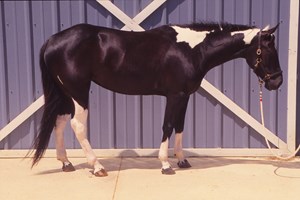Finding Your Horse’s Center of Gravity
- March 10, 2017
- ⎯ Equus
The most exciting biomechanical idea current in the latter half of the 19th century was the discovery of the “center of gravity” (CG). An invisible, infinitely small point, the CG is nevertheless real: it is the point at which a body fundamentally responds to a gravitational field. The CG is the point about which a body spins without wobble and from which it can be suspended without tilting.

Although Sir Isaac Newton discovered and described the CG, the idea quickly was applied to the ridden horse. Both the rider and the horse possess a CG; part of the trick to “sticking on” is to align and synchronize the separate CGs of rider and horse. Even before Newton’s time, sensitive riders, through their “feel,” already were aware of the existence of a “balance point” or “axis of movement” in their horses. These riders found that the easiest place to sit is over this axis, for like the axle of a wheel, it is in the place in the moving horse which remains most still.
To find the location of your horse’s CG as seen from the side, take the following steps:
1. Photograph the horse. Put the horse in a paddock with short grass or in a dry lot, so that tall grass won’t block your view of his legs and feet. Halter the horse and have a friend hold the line loosely. It is essential for the horse to stand squarely, and it is helpful if he is relaxed or even snoozing.
Load your camera with print film. Back away 10 to 20 feet from the horse. Then, standing exactly opposite point “X” (see drawing below), snap the picture. If you stand closer to the shoulders, they will be artificially enlarged in the photograph; likewise, the hindquarters will appear too big if you stand too close to them. In either of these cases, the result of your search for the CG will be distorted.
2. Enlarge the photo. After the print is developed, take it to a photocopying machine that has the capability for producing enlarged copies. You probably will need to make several generations of enlargements. To do this, set the machine for maximum enlargement. Photocopy the print. Then photocopy the first photocopy. Continue doing this until the image of your horse measures eight to 10 inches from nose to tail (i.e., until it is almost too big to fit on an 8 1/2-by-11-inch sheet of paper). Don’t be concerned if the second or third enlargement looks dark; to find the CG, all you need is a crisp silhouette.
3. Transfer the outline to heavy paper. Take the photocopied enlargement and tape it to a sunlit window. Using a soft pencil, draw a wide band that covers the edges of the silhouette. This process is called “blacking the back.” Then remove the paper from the window.
Now tape the photocopy to a sheet of heavy paper, penciled side down. Using a ballpoint pen and moderate pressure, carefully go over your horse’s silhouette. Then remove the photocopy. (You can also use carbon paper to accomplish this step.)
4. Cut out the silhouette. Using a small, sharp pair of scissors or a razor knife, cut out the silhouette. Follow the traced outline exactly, with the following exceptions: cut off the tail at the foot; “trim” the mane if it is bushy.
5. Spin for the CG. Using a long pin (a large sewing pen or a hat pin is ideal), poke a hole anywhere in the cutout silhouette. Enlarge the hole just enough to make the pin fit in it freely; this can be done by pushing the pin in and gently withdrawing it several times.
Holding the pin in one hand, tap or push the silhouette so that it spins around the pin. If the silhouette always stops in the same position or spins asymmetrically, the pinhole you’ve made isn’t in the position of the CG.
It will be obvious after the first couple of tries which direction you have to go to make a better guess at the location of the CG. Keep poking holes and spinning the silhouette until you find a point around which the cutout spins with perfect smoothness and stops at random. The CG of most horses is located in the chest, at a point behind and above the elbow.
In Principles of Conformation Analysis, Volume 1, an EQUUS reference guide, Dr. Deb Bennett explains how to see a horse from the inside out to determine his capabilities and limitations. To order the book, call 1-800-952-5813 or visit HorseBooksEtc.com.








